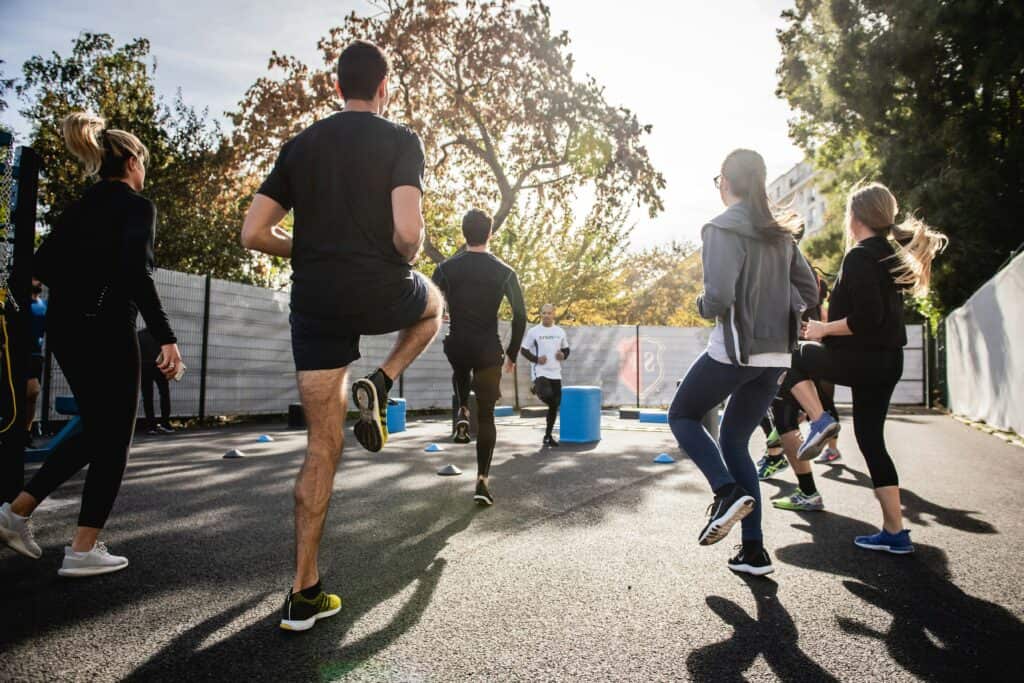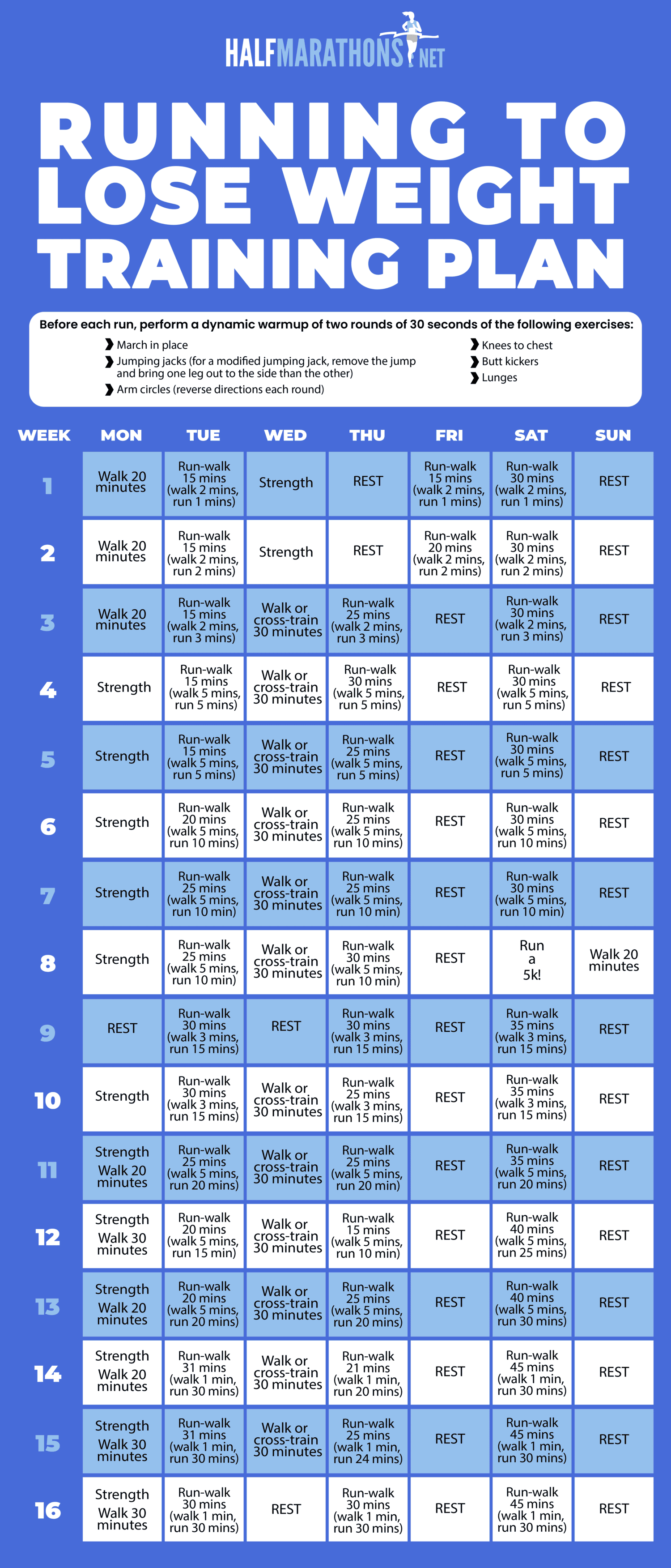People take up running for all sorts of reasons, and it delivers a whole host of benefits from better mental health to feeling more empowered to an exciting new way to vacation around the world. But if you’re looking for a running plan to lose weight, the sport can indeed help you reach that goal, too — but we are firmly on the healthy approach to such a goal.
At Half Marathon Guides, we’re long-time experts in all varieties of running plans; for how to lose weight specifically, we’ve tapped registered dieticians, running coaches, and fitness specialists to create an effective and well-balanced approach for you.
What you won’t find in our guide: Guidance on cutting fat, gaining six-pack abs, or exercising your way out of guilty-pleasure foods. While that can be a nice byproduct of running for some genetically-blessed fitness buffs who develop a “runner’s body”, this guide to weight loss through running is about cultivating health, wellness, confidence — and enjoying the sport of running rather than the physical results it may bring.
Is Running Effective for Weight Loss? What Science Says

If you’re wondering if running is actually a good way to lose weight, then the simple answer is: Probably. But it’s not a magic pill. And there are a few things you should know for it to be an effective weight loss tool.
How Running Can Help You Lose Weight
“Running is a form of exercise and we know exercise demands energy by way of caloric burn,” says Jordan Hill, CSSD, MCD, a registered dietician at Top Nutrition Coaching.
She explains that running, like other forms of exercise, combined with a healthy fueling plan, can be a great way to achieve weight loss.
At its core, this is because of the likely-familiar idea of calories in versus calories out. Said differently, running is a tool to help you maintain a calorie deficit to lose fat. Conventional knowledge says one pound of fat is equal to 3,500 calories. To lose one pound of fat per week, you would therefore operate at a 500-calorie deficit per day.
“In general, the calories in versus out is an approach that can assist with weight loss for runners and non-runners alike,” Hill confirms.
Running regularly can also help prevent weight gain and might improve your overall body composition. One study, published in the Journal of Physiological Anthropology, found that most people running at least 13 miles a week showed significant changes in body mass and visceral fat.
Who It Might Not Work For
Some runners won’t see big changes in their body weight. This is especially true if you don’t have much fat to lose in the first place.
But also, running alone might not give you dramatic or sustainable results: A study published in Frontiers found that running might only lead to short-term weight loss. The study also found running is most effective when used alongside strength training. (We love strength training for all runners, but it’s important to note this study only looked at male subjects so there are limitations to their findings.)
More importantly, a running plan to lose weight is nothing without the right nutrition plan. Food and how it affects our body is complex. For most, losing weight is not as simple as eating less and running more. Obesity specialists have found that calorie counting doesn’t produce consistent outcomes. The way your body metabolizes calories is influenced by various factors such as:
- The composition of your diet
- Your metabolic rate (i.e. the number of calories your body needs to function)
- The microorganisms in your gut
Hill says it’s important to focus on the nutrient value of the foods eaten — macronutrients, micronutrients, fiber, antioxidants, etc.. “This helps to ensure we’re supporting energy output, athletic performance, and overall health and wellness,” she adds.
The good news is that running will burn calories and increase your metabolism. But the other factors still stand.
Lastly, if you hate running, this probably isn’t the right approach for you. The concept of exercising into a calorie deficit applies to any form of cardio exercise, so you can achieve similar results by taking up other cardio activities like swimming, rowing, and rollerblading, alongside strength training — and will probably be a lot happier reaching your goal with an activity you actually enjoy.
Your Totally-Doable Running Plan to Lose Weight

The best running plan to lose weight is simply the plan you’ll stick to and enjoy doing for weeks on end.
Conti and Coviello agree that for people just starting out, the run-walk method is the most approachable. A Couch to 5K or, even better in our opinion, Couch to Half Marathon plan can get your mileage up enough for effective weight loss.
Coviello has created the below, 16-week running plan to lose weight for those starting at zero miles.
If your fitness level is higher than a beginner’s or you’re used to physical activity, you may be ready for a more advanced running program.
The Training Plan
Before each run, perform a dynamic warmup of two rounds of 30 seconds of the following exercises:
- March in place
- Jumping jacks (for a modified jumping jack, remove the jump and bring one leg out to the side than the other)
- Arm circles (reverse directions each round)
- Knees to chest
- Butt kickers
- Lunges

Tips for How to Lose Weight Running
Using running as a weight loss tool requires mental and physical commitment. Here’s how to get started — and keep going:
1. Find your “why”
Author, RRCA-certified running coach, and chronic disease fitness specialist Christine Conti explains that your desire to run needs to come from intrinsic goals, not just extrinsic desires. The difference is:
- Intrinsic motivation comes from within you. These goals are about purpose, mastery, curiosity, self-discovery, and challenge.
- Extrinsic motivations are goals that are outside you, like money, outside validation and praise, point — or in running — time goals.
Think about it this way: If someone offered you $1 for every mile you run, your motivation would probably start to wane after a week, a month, or a year. But if you start to run because you want to be healthy and live longer for your partner and kids, or to challenge what you believe yourself to be capable of, you might not be so quick to abandon the plan.
You have to find that internal “why.”
And the first why: “Why do you want to lose weight? That’s number one. Before we even start running,” Conti says. If your reason is to fit into your size 4 pants again, why? What do they represent to you? Why is that feeling important?
The deepest “why” will be your motivation as you embark on your running and weight loss journey.
“Running isn’t easy,” Conti says. “If you have a good why, you will have continuous motivation.”
2. Set small goals

It’s important to set clear and measurable goals — but these should be running goals and not a number on the scale. That’s because your body weight might not budge right away. Your body might be holding onto water or building muscle. But your body is still making progress by adapting to your new workout routine.
Start small: A goal could be making it through the first week of your training plan. Don’t shy away from setting big goals, like running a half marathon or full marathon.
But these smaller goals are your steping stones to your bigger, long-term goals, Conti says.
3. Start slow
If you aren’t currently active, don’t go out and try to run a mile right away. In fact, for the first week, your goal might be as simple as “moving more,” says RRCA-certified running coach Erica Coviello.
She encourages her beginner clients to take walks, stretch, and explore different options that feel good to their bodies.
And when we say “start slow,” we mean literally: There is no need to sprint when you are first starting out — you’ll get faster and add bursts of speed later on. In fact, many people follow a run-walk plan during a full half marathon.
Walking is a great activity that burns calories (albeit less than running) and will likely be used in most training plans for new runners. Not only will a gentle progression make running feel easier, but Coviello says it will keep your body less sore and decrease your risk of injury.
4. Focus on what you eat

Not all calories are created equally, Hill says.
“You have to focus on whole foods that offer a variety of nutrients,” she says. Do this by:
- Balance your meals and incorporate nutrient-dense snacks. This provides essential nutrients even while targeting weight loss.
- Incorporate lean proteins, complex carbohydrates, healthy fats, and fruits and vegetables.
- Eat simple carbohydrates before, during, and sometimes after your runs.
5. Time your meals with you runs
Timing is an essential part of your fueling plan. You want to eat regularly meals and fuel properly before, during, and after runs, Hill says.
Here’s a look at how to fuel your runs when working to lose weight:
- What to eat before a run: Try to eat something light 30 minutes before you run. Snacks for runners like string cheese and crackers or nut butter on whole grain bread are great options.
- During a Run: If you’re running for less than 90 minutes, skip the mid-run snack. Running longer than 90 minutes, fuel with 100-calorie snacks, ideally things you can eat quickly while on the go. This means gels, sports drinks, jelly beans, dried fruits, or bananas, depending on what your stomach can handle. Fueling during a run is meant to keep your glycogen stores up to prevent you from hitting the wall or cramping.
- After a Run: Focus on rehydration and replacing the calories your body burned. Start with a large glass of water or a sports drink. Next, try to eat a light snack that includes carbs, proteins, and healthy fats within 30 minutes of your run, like an apple with nut butter or a hearty salad with chicken.
6. Don’t skip meals
You might be really hungry when you first start training. Snack often to avoid binging on empty calories. If you do splurge, don’t freak out. Show yourself grace and then prepare a meal rich in nutrients.
The weight will come off without a massive calorie deficit. Hill says to make sure you don’t skip meals. This will do more harm to your body in the long run.
“If we’re not consuming enough calories to support the output we’re doing, then we begin to break down muscle for energy,” she says. “Muscle loss means a loss in strength. Not great for sports performance and not great for injury prevention. This is also why nutrient timing is important so that we give our body fuel when it really needs it.”
7. Follow the right running plan
Having a plan is kind of like having daily goals. Each day, you can check off a 20-minute run. It keeps you on track with your running like a map to health and fitness. Having a plan is especially useful if you’re training for a race. We have different training plans for every type of runner, but if you’re looking for a running plan to lose weight specifically, see our guide above.
8. Prioritize strength training

Cardio is awesome, but resistance training has a ton of benefits and is proven to rev your metabolism and improve body composition. Adding strength training to your plan will help with weight loss while maintaining, and even building, muscle mass.
Kettlebell workouts will make you a better runner, but in general, the best strength training plans will incorporate the muscles you need for running to keep injuries at bay. Coviello says to prioritize exercises targeting your core, lower body, and upper body to help your running posture and mechanics.
9. Celebrate your wins
“The only way that you’re going to lose weight by running is if you make it enjoyable,” Conti says. “To do that, the small teeny wins — we celebrate the heck out of them.”
As you build up your endurance, celebrate milestones. Things like:
- Your first time running 10 minutes straight without walking
- Running your first mile
- Running to a certain landmark
These all deserve positive attention. Just take a moment — maybe even looking in the mirror — and telling yourself “Good job.”
“I’ve interviewed a lot of people over the years and they’ll say, no one enjoys running,” Conti says. “You know what you enjoy? You enjoy the feeling of satisfaction when you’re done.”





